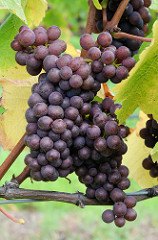Dolcetto – They are Dark, Skinned red wine grape, whose origin is in the north western hills in Italy. Though, a variety has successively made their way to vineyards where it was once thought to be just like charbono. Its plantings are very limited in hills of Liguria even though it masquerades in the same. Dolcetto has a tough time getting the attention it deserves, Dolcetto is competing
against a beverage that has been known since as the mid-1800s as “The king of Wines” known as Nebbiolo. Outside of Italy, Dolcetto is known as Douce Noire in Savoie and Charbono in California, which you might be knowing.
These Dolcetto produce soft-styled, fruit-driven wines with low acidity, particularly when compared to those made from angular Nebbiolo and tangy Barbera, It has low acid levels which have earned the wine its name Dolcetto meaning, sweet little one. Dolcetto has rather pronounced tannins which, if not softened by a short-but-sweet fermentation, can lead to imbalance as well. Dolcetto isn’t meant
for deep thought but simply for happy drinking. You can chill it lightly. You can serve it with light meals like burger or something. Dolcetto wines can be made approachable within few months of harvest, rather than years..honestly. Thus Dolcetto sales provide a buffer zone in the annual winery budget, helping to balance the books and keep things ticking over until the more expensive wines are ready for
sale in the market.
The wine- Dolcetto di Dogliani, and Dolcetto di Dogliani Superiore are Italian red wines produced in the Langhe using only the Dolcetto grape variety. Dolcetto wines are known for black cherry and licorice flavors with some prunes. Dolcetto is considered as light & beadydrinking red wine that pairs well with pastas and pizza dishes etc. This wine is sometimes likened to Beaujolais, although a young Dolcetto is nearly always a more attractive and more gently priced alternative. The Italians like this wine for everyday drinking because of its soft tannins, ripe fruit, and ability to match with a variety of foods they have.
There are many famous Dolcetto Grape wines varying from low to higher prices..such as,
1) Dolcetto d’Alba boschi di berri 2001 marcarini – Very traditional style with mature meaty flavours, soft ripe tannins, lovely structure, hints of saddle leather and truffles, and a spicy Marmite finish.
2) Dolcetto d’Alba Munfrina 2005 Pelissero -Very scented bouquet, luscious ripe fruits, soft rounded palate with a beautifully velvety finish.
3) Dolcetto d’Alba 2005 GD Vajra -Lovely blackberry and cherry-scented fresh bouquet, open knit, melted liquorice notes, smooth, succulent tannins with slightly spicy finish.
4) Dolcetto d’Alba Coste e Fossati 2005 GD Vajra – Slightly meaty, spice box, roasted coffee notes.
5) Dolcetto d’Alba 2005 Rivelli Serafino – Fragrant, full, very good ripeness, heady, unusual sweet notes, well integrated tannins.
6) Dolcetto d’Alba 2005 Ascheri- Light perfume aromas, initially sappy juicy fruit, but lightweight and too coarse and grippy to finish.
7) Burlotto Dolcetto d’Alba 2009 – with a nose of blackberry, cherry and almond. Carrying onto the palate with added spice, this medium to full bodied wine cleverly shows great elegance.
ETC.
The easy, fruity one; the early-picked one; the inexpensive one; the one that the piemontesi drink for lunch; the light, refreshing, non-think one. despite the judgment of most experts that Dolcetto is a grape that does not thrive on saturation, one that needs short maceration, having plenty of its own tannins without addin those of oak, an other stuff. The finest Dolcetto wines come from grapes grown on soils rich with white marls, especially those found on the right bank of the River Tauro.
Dolcetto is universally known as producing deep violet-coloured wines, with abundant aromas of red crushed fruit, and etc. Dolcetto is nowhere near such an upgrade, but this may have less to do with its intrinsic qualities than its perceived reputation as a simple variety. The story so far is very similar to that of Barbera, a grape variety, which, shared Dolcetto’s Cinderella status. And so, The conventional way of vilifying the grape aims at getting as much – colour out of the grapes without leeching tannins out of the pips. Therefore most producers minimise the maceration time in tank and ferment at lowish temperatures to preserve fruitiness.
Daniel Andrew Khong
http://www.wineblogtips.com

